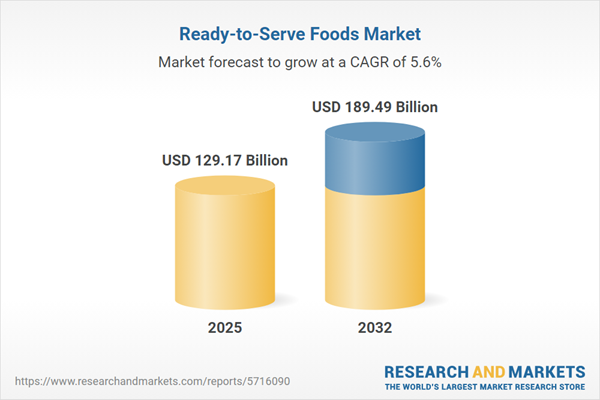Speak directly to the analyst to clarify any post sales queries you may have.
The ready-to-serve foods market is undergoing rapid transformation as businesses respond to evolving consumer needs by upgrading operational strategies and embracing new retail dynamics. Senior executives navigating this sector require clear, actionable insights and streamlined frameworks to drive profitability and sustained relevance.
Market Snapshot: Ready-to-Serve Foods Market Size and Growth Outlook
In 2024, the ready-to-serve foods market reached USD 122.27 billion, with a projected rise to USD 129.17 billion in 2025 and USD 189.49 billion by 2032, representing a CAGR of 5.62%. Growth is fueled by surging interest in convenient and healthy meal options, strengthened supply chain investment, and targeted logistics optimization. Industry participants are adapting to health-focused consumer decisions, leveraging multi-platform retailing, and addressing compliance evolution to reinforce resilience and maintain an edge over competitors.
Scope & Segmentation of the Ready-to-Serve Foods Market
- Product Types: Offerings include ready meals, salads, snacks, soups, breakfast items, entrées, and side dishes. These products address a wide range of dietary needs and allow brands to target consumer segments prioritizing convenience and personalized nutrition.
- Packaging Types: Solutions range from canned, chilled, and frozen to advanced preservation formats, including blast-frozen and individual quick-frozen variants, alongside shelf-stable options. Such packaging maximizes safety and longevity while facilitating flexible storage and transportation.
- Distribution Channels: Key channels comprise supermarkets, e-commerce platforms, and convenience stores. Multi-channel approaches bridge digital and physical retail, strengthening reach to diverse buyers and fostering adaptable supply strategies.
- End Users: The primary user groups are households and foodservice operators (including both quick-service and full-service restaurants), driving demand for solutions that meet varied consumption patterns and operational needs.
- Protein Sources: Included in product portfolios are beef, chicken, seafood such as fish and shellfish, along with vegetarian options, supporting companies in aligning with shifting nutritional trends and ethical considerations.
- Price Tiers: Ready-to-serve foods are available across the value spectrum, from mass market to ultra-premium tiers, enabling businesses to address changing economic landscapes and customer expectations.
- Regions: The market is segmented by the Americas, Europe, Middle East & Africa, and Asia-Pacific, each with distinct consumption habits, regulations, and cultural influences, emphasizing the critical need for regionally nuanced strategies.
- Key Players: Notable participants include Nestlé S.A., Conagra Brands, The Kraft Heinz Company, Campbell Soup Company, General Mills, Hormel Foods, Ajinomoto Co., McCain Foods, Nomad Foods, and Unilever PLC, whose operations influence broader industry development and innovation priorities.
Key Takeaways for Senior Decision-Makers
- Diversification of product offerings is vital for meeting evolving consumer preferences around healthier and more convenient solutions, enabling sustained relevance amid ongoing sector change.
- Integrating advanced digital tools for channel and sales management elevates customer experiences and ensures a competitive stance in both online and traditional retail venues.
- Sustainability remains a critical focus, particularly via innovative packaging and agile supply chain compliance, aligning with heightened standards and end-user scrutiny.
- Expanding into functional and personalized nutrition products supports engagement across different lifestyles and wellness values, unlocking broader market access.
- Adaptable pricing strategies contribute to organizational agility during economic volatility, and strengthen the ability to maintain perceived value in the eyes of target segments.
- Customized regional offerings—through tailored product selections or localized compliance—bolster market differentiation and reinforce relevance within diverse regulatory contexts.
Tariff Impact: Navigating Regulatory Shifts in the U.S. Market
Shifting U.S. import tariffs are contributing to higher operational expenses, most notably for packaging and raw materials. To address margin pressures, organizations are increasingly prioritizing domestic and nearshoring sourcing strategies. Foodservice operators are negotiating vendor contracts and updating menu practices to adapt to pricing tensions while still meeting service quality expectations. The adoption of automation and upgraded logistics processes further supports cost containment and service consistency.
Methodology & Data Sources
This analysis is grounded in interviews with executives, comprehensive consumer studies, and systematic reviews of leading trade publications, regulatory resources, and authoritative market databases. Strategic insights derive from rigorous statistical modeling, including time-series and regression-based approaches tailored to sector-specific decision requirements.
Why This Report Matters for Decision-Makers in the Ready-to-Serve Foods Market
- Delivers actionable frameworks that help leadership teams confidently anticipate and respond to sector shifts and emerging consumer expectations.
- Clarifies how trends in sustainability, digitalization, and regulatory adaptation directly influence supply chain and go-to-market strategies.
- Equips decision-makers with substantiated guidelines for investment choices, risk assessment, and strategic partnerships, supporting long-term organizational priorities.
Conclusion
Success in the ready-to-serve foods market hinges on strategic agility and data-driven planning. Organizations capable of proactively adapting to shifting dynamics stand to secure lasting competitive benefits and capture new opportunities for growth.
Additional Product Information:
- Purchase of this report includes 1 year online access with quarterly updates.
- This report can be updated on request. Please contact our Customer Experience team using the Ask a Question widget on our website.
Table of Contents
3. Executive Summary
4. Market Overview
7. Cumulative Impact of Artificial Intelligence 2025
Companies Mentioned
The companies profiled in this Ready-to-Serve Foods market report include:- Nestlé S.A.
- Conagra Brands, Inc.
- The Kraft Heinz Company
- Campbell Soup Company
- General Mills, Inc.
- Hormel Foods Corporation
- Ajinomoto Co., Inc.
- McCain Foods Limited
- Nomad Foods Limited
- Unilever PLC
Table Information
| Report Attribute | Details |
|---|---|
| No. of Pages | 196 |
| Published | October 2025 |
| Forecast Period | 2025 - 2032 |
| Estimated Market Value ( USD | $ 129.17 Billion |
| Forecasted Market Value ( USD | $ 189.49 Billion |
| Compound Annual Growth Rate | 5.6% |
| Regions Covered | Global |
| No. of Companies Mentioned | 11 |









